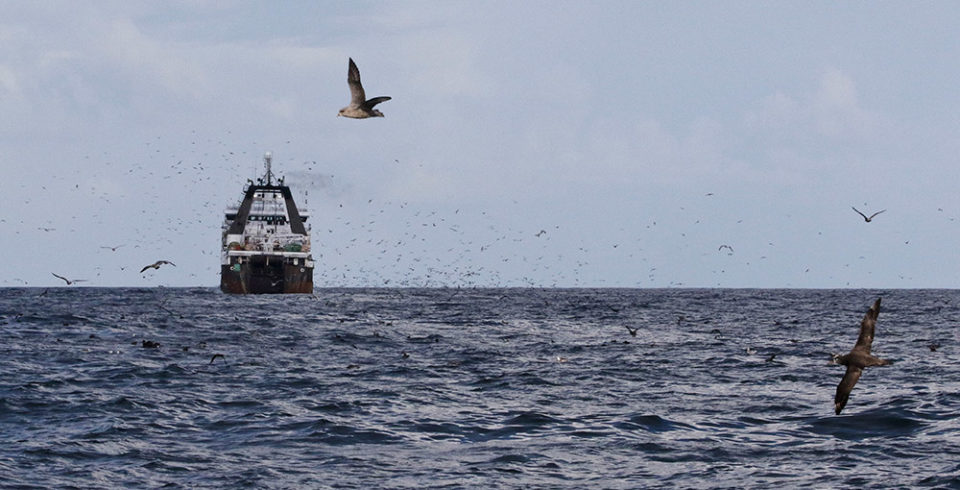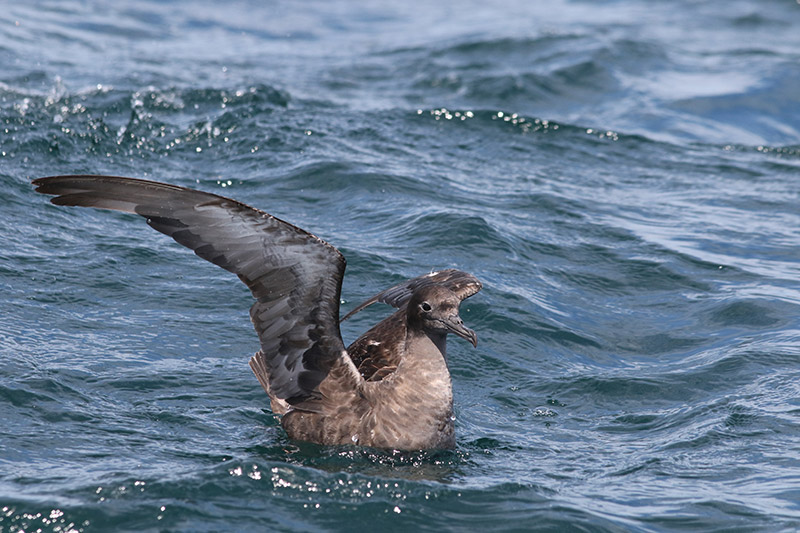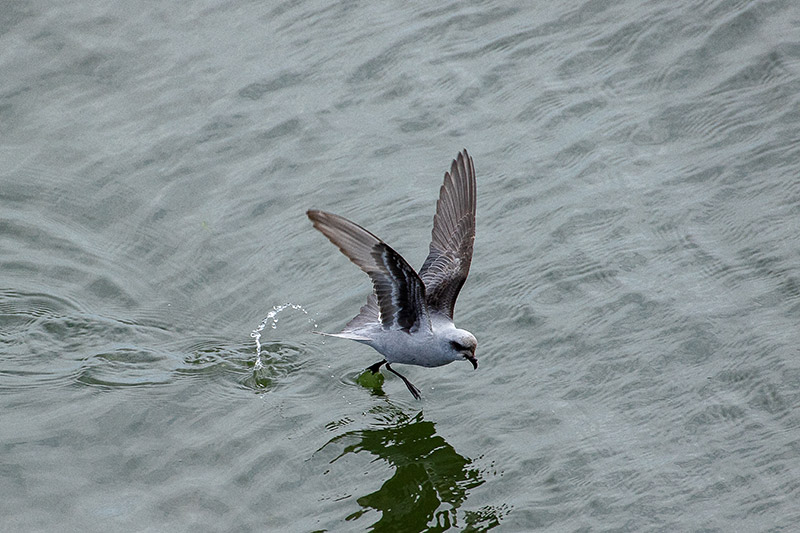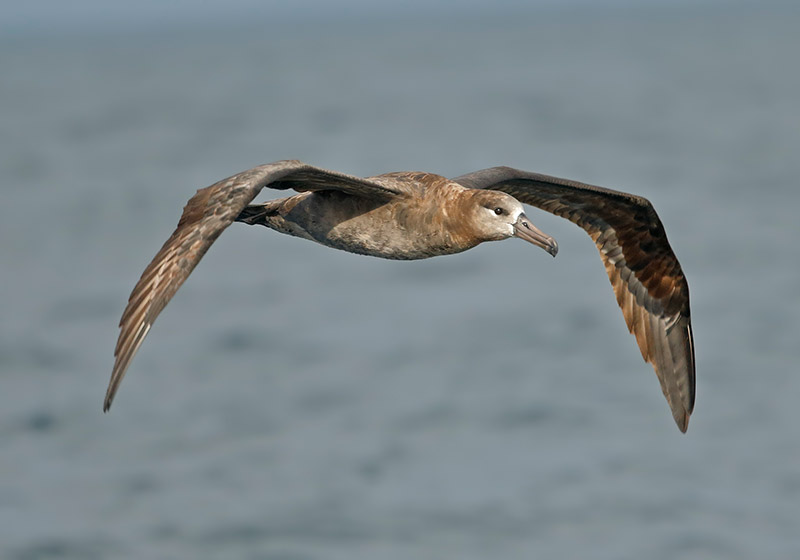
Summer is the season when we love to get out on the waves and enjoy all that Washington coastal waters have to offer: surfing, swimming, sailing, fishing or just cruising.
As it turns out, we’re not the only ones.
Just over the horizon, where most beachgoers and other landlubbers will never see them, pelagic birds are doing all the same things. Pelagic birds, by definition, spend the vast majority of their lives out on the open sea, returning to land only to nest – usually on remote islands.
Partly because of that inaccessibility, and partly because of the mythology around them, this birder’s favorite pelagics are the tubenoses – so named for the tubelike sheath around their nostrils. This group includes albatrosses, petrels, shearwaters and storm-petrels. They are the true Ancient Mariners, having survived the mass extinctions of the Late Cretaceous unscathed and nearly unchanged. If it ain’t broke, don’t fix it.
The tubenose itself, fancifully called a narnicorn, is a hard structure atop the bill (or on the side for albatrosses) that performs two crucial functions for the birds. First, it funnels faint scents to the nostril, helping the bird pinpoint the location of a potential meal that may be a mile away. (Good to have when your food is tucked between identical waves in an unbroken line to the horizon.)

Second, the tube is a handy portal for excreting salt. Glands in the bird’s head filter salt from the body, oozing a hypersaline solution through the nostril, where the tube directs it safely away from the eye to drip harmlessly down the bill. (A fine adaptation for a creature whose beverage menu only offers seawater.)
Another peculiarity among tubenoses is the nutrient-rich but foul-smelling oil stored in their stomachs. It’s the duct tape of the albatrosses, performing many functions. It can be used as baby food, as an energy bar on a long flight, or as a weapon when regurgitated at a predator.
Thanks in part to these innovations, tubenoses are the most widely distributed avian order, nesting from inland Antarctica to northern Greenland and foraging far and wide, sometimes well over 1,000 miles from the nest. Few nest in Washington waters, but several can be found here this time of year – provided you can get yourself out to the edge of the continental shelf.

Shearwaters and storm-petrels
Most common here in late summer is the sooty shearwater. When their circular migration pattern brings them through our area as they head for their nesting islands in the sub-Antarctic, you might even see them from shore: a seemingly endless wave of thousands of sleek, long-winged birds flying low over the water at horizon’s edge.
One of these flocks managed to leave its mark on American cinema, providing models for the Alfred Hitchcock classic “The Birds.” In the middle of the night on Aug. 18, 1961, hordes of sooty shearwaters – crazed and disoriented by toxic algae – bombarded the town of Capitola on Monterey Bay, California, just up the road from Hitchcock’s residence. Thousands of birds crashed into buildings (and even some bewildered people), regurgitating poisoned fish and eventually littering the streets with their corpses. Hitchcock, as luck would have it, was already working on his film adaptation of Daphne du Maurier’s novelette, and he used the bizarre news story to augment his work.
One tubenose that does nest off the Washington Coast is the tiny fork-tailed storm-petrel. Judging by how quickly they arrive when chum is put out, they may have the best sense of smell of all our locals. That’s not the only adaptation that serves them well. Fork-tailed parents spend the entire day out at sea, where they use comblike structures on their bills to filter organic oils and plankton from the water. They often hover just above the waves, pattering their feet over the surface. This behavior has given them their Latin name, Oceanodroma (“water runner”), as well as their English name (derived from St. Peter, who briefly walked on the water at Jesus’ behest). They return to the nesting burrow only under cover of darkness, foiling diurnal predators like the bald eagle.
Problem is, Mom and Dad don’t make it home every night. Their amazing egg, about one-fifth of a parent’s weight, is so hardy it can survive up to a week without incubation. Once the chick hatches, it is equally rugged. If it’s not fed for a few days, it can slow down its metabolism, going into a torpid state until a breadwinner comes home with food.

Albatross
Perhaps the most enigmatic and storied birds in the world are the albatrosses, including our regular visitor, the black-footed albatross. These large seabirds nest mostly on islets in the Hawaiian chain, but young and non-breeding birds are a fairly common sight in our offshore waters. Even with its impressive 7-foot wingspan, it is one of the smaller albatrosses. Its southern cousin, the wandering albatross, dwarfs it with a world-record 11-foot reach! The title of longest-lived bird also belongs to an albatross named Wisdom, who last year laid an egg at age 68.
It is no surprise that this awe-inspiring bird figures heavily in many mythologies. Their family, the Diomedeidae, is named for Trojan war hero Diomedes, whose men were turned into birds by an angry Aphrodite. Pacific island cultures consider them vessels for gods and ancestors. The idea of souls carried in albatross bodies recurs in old sailors’ lore, where they were thought to be the incarnations of drowned seamen, the killing of which would bring grave consequences.
The equivalency between albatrosses and humans is perhaps not so farfetched. Like us, they take marriage seriously. Once a bird is mature, at about 3 years old, it will return to the nesting colony to find a forever mate. Unlike most birds, though, they will spend years courting and establishing a pair bond before actually starting a family. They’ll spend those dating years dancing, kissing (clattering bills together) and building nests. Only after a long engagement will the single egg be produced, incubated alternately by the new parents.
Except after a harsh storm, when some tubenoses may be blown closer to shore, the only way to see these awe-inspiring birds is from a boat. You can arrange a deep-sea fishing charter, or join one of the regular pelagic birding trips with Captain Phil Anderson at Westport Seabirds. Only then can you say, as American ornithologist Robert Cushman Murphy did in 1912, “I now belong to the higher cult of mortals, for I have seen the albatross.”